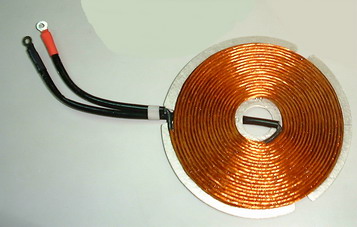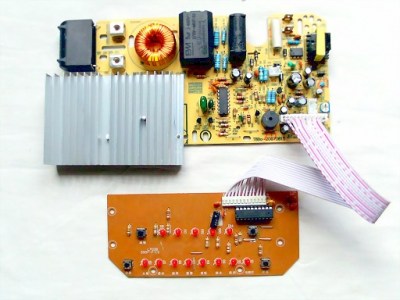Induction heating is the heating of an electrically conducting material using the energy from Electromagnetic radiation. The process of electromagnetic induction creates Eddy currents (Foucault current) in the conductor and by the process; the resistance causes the conducting material to heat up due to Joule heating. Induction cooking is the Flameless cooking that exploits the ferromagnetic property of some metals and electromagnetic induction.

The induction heater has an electromagnet through which high frequency AC passes. The frequency of AC used depends on many factors including the material and size of the conductor and coupling of the work coil and conductor. Mains frequency 50Hz or 60Hz is used in many practical applications including Induction Cooker. Iron and alloy conductors respond well with induction heating due to ferromagnetic property.
In induction cooking, heat generates in the cooking pot directly and not in any other part of the cooker. But the cooking pot must be a ferromagnetic types, one like Iron or Steel .
The induction cooker has a large circular coil made up of enameled copper windings placed under the space for the pot. When AC of a particular frequency passes through the coil, an oscillating magnetic field develops which induces electric current into the pot material. When this Eddy current (Not a shocking one) passes through the material of the pot, friction develops in the molecules( don’t be confused, the molecules of the pot material) and heat develops. This heat is transferred to the water to boil the contents in the pot.

Induction Coil
Inside view
The structure of induction cooker is very simple and there is no bulky part inside. Besides the large circular coil, it contains a Microprocessor based circuit board to control various functions and to regulate the frequency of AC passing through the coil and a cooling fan . Nothing other than these parts present inside.

How it becomes efficient?
Induction cooking is energy efficient and faster than the conventional flame cooking or heater. One important feature of induction cooking is that energy level and power utilization can be controlled depending on the use and there is no wastage of electricity as in coil heaters. Another attracting feature is that there is no shock hazard or burning since the induction heating occurs in the cooking pot itself. Only the surface of the cook top is heated from contact with the pot. The air around the induction heater will not heat up which further increases the energy efficiency of the device.

Efficient induction cooking takes place if steel vessels are used because of its magnetic properties and the steel concentrates all the induced currents in the surface so that the heating effect becomes stronger. Aluminum and other non magnetic materials are not good for induction cooking, since the induced magnetic field penetrates deep into the material creating only little resistance.
Induction cooker has many monitoring systems for efficient functioning. It can detect whether there is a ferromagnetic pot over it by sensing the heat. It can also sense whether there is any content (water or food) inside the pot. It also shut off if any one of these conditions is not satisfied. This prevents hazardous results as found in gas cooking or heater cooking.
Some important features of Induction cooking are:
1. Thermal efficiency- maximum heat generation using small current.
2. Heat consistency- Heat generation is uniform and constant throughout the period.
3. Less time – Duration for cooking is half or less than half than Gas cooking. But the time depends on the quantity and type of food. Stir drying is faster than water boiling.
4. Safer- It is safer since there is no open flame or hot pans.
5. Clean- Pots can be easily cleaned since there is no smoke accumulation and the pot surface is flat.
6. No shock – There is total isolation of heating surface and the internal electric circuit. There is air gap between the underneath coil and the cooking surface.
7. Cool cooking surface- The cooking surface (space for placing the pot) is made up of a poor heat conductor so that heat will not be transferred from the pot to the surface. The cooking surface can be touched easily after removing the pot.
8. Light weight- Portable and easy to handle.
9. Power consumption – Depends on the watts used and duration of cooking. Anyway, cost effective than gas cooking or heater cooking.
10. Some interference – Radio frequency instruments, Cardiac pacemakers etc may function erratic near the induction cooker due to strong magnetic field.
Cookware
In induction cooking, cookware’s are most important. Not all vessels or pots cannot be used since magnetic induction is required for induction cooking.
1. Black metal or Iron pots are best.
2. If stainless steel pot is used, it should be in the ferromagnetic category.
Current consumption
Many of us doubt that, there is much current consumption in Induction heating. See some facts about current consumption.
In Coil heater, much of the current is wasted and efficiency reduces to 20-40%.But in Induction heating, energy wastage is very low and efficiency is 80-90%.The comparison can be
In Coil heater, coil takes huge current (depends on the size, length, resistance etc of the coil) to heat up. In induction heater, current is regulated through the coil by the microcontroller.
Heat loss occurs in coil heater through the air space between the coil and pan. In induction heater, the pot material is heating and there is efficient energy transfer through the inner surface of the pot.
When the input AC voltage drops, coil heater uses much current and takes long time to cook but in Induction heating, voltage is regulated and current consumption is uniform. Moreover, it takes half of less than half time for cooking.
The wattage of the coil heater is fixed (1000- 3000 watts) so that power consumption is same irrespective of the quantity of cooking food. But in induction heater, power can be adjusted from 200 watts to 1800 watts depending on the type of cooking like hot pot or frying.
Some facts about domestic power consumption
Domestic power supply is either 230 volts 50 kHz or 110V 60 Hz. The domestic current consumption depends on the Wattage of the instrument used. Current consumption is calculated using the formula
I = W /V
I is the current used in amperes, W is the wattage of instrument and V the 230 volt power supply.
For example a Coil heater rated 1000 Watts consume 4.35 ampere current in one hour at 230 volts.
Wattage of an instrument can be calculated using the formula
W= V x I
Electricity billing
Electricity billing is based on the usage of current by the domestic appliances. If a 1000 watts Coil heater is used for one hour, 1 unit current is used. Current consumption is calculated using the formula
Total Watts x 1 hour / 1000
For example, the total wattage of all the electric appliances used is 500 watts, the power consumption in one hour will be
500 x 1 / 1000 = 0.5 units
If the consumption per hour is 0.5 units and the appliances are used 8 hours per day, then the power consumption will be 4 units per day and 120 units per month
Precautions
. Switch on the Induction cooker only after placing the Pot with material.
. Switch off the device before removing the pot.
. Do not unplug or switch off the power from AC outlet till the cooling fan stops running. This is necessary for removing all the magnetic field accumulated in the device.
. Use a Pot having circular flat surface with diameter that exactly matches with the marking of the pot surface of cooker (The pot surface has the same diameter as that of the coil inside). This increases the efficiency of cooking.
. Always clean the Pot base before placing over the induction cooker.
. Always clean the cooker surface after cooking.
. Keep the induction cooker in a well ventilated, moisture free area.
. Unplug the cooker from the AC outlet after the use.
Filed Under: Electronic Projects


Questions related to this article?
👉Ask and discuss on EDAboard.com and Electro-Tech-Online.com forums.
Tell Us What You Think!!
You must be logged in to post a comment.